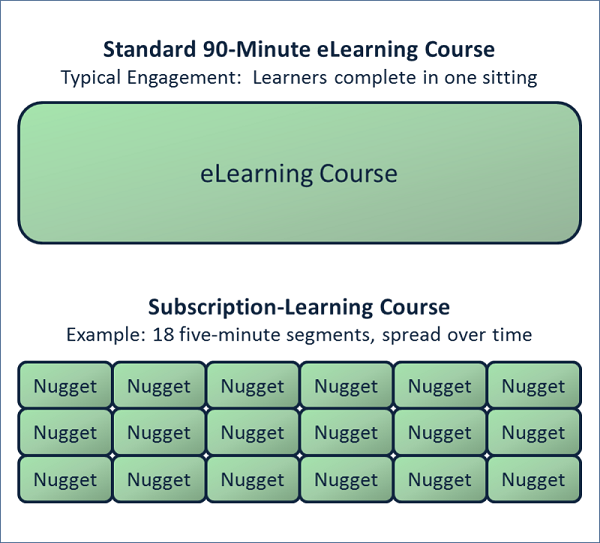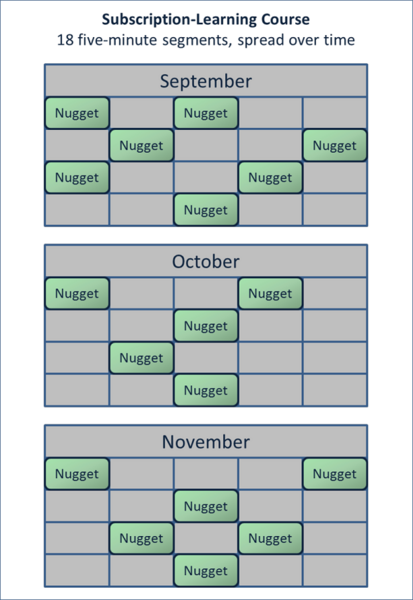ATD Blog
Stuck in an E-Learning Box? Try Subscription Learning
Tue Jul 08 2014

Bookmark
Human beings often think in ways that limit our understanding. For example, when we think of germs, we think to kill them or avoid them—even though we rely on good bacteria to keep us healthy. When we think of wildfires, we think of stopping them—even though fires actually help forests stay healthy and limit the size and damage of future wildfires.
What do we think about when we think “e-learning?” This is a critical question for each of us because the way we think about e-learning may be limiting our options for improving learning and performance.
Too often, we just take an old method and port it over to a new technology. Indeed, many current e-learning offerings simply use the classroom-presentation approach to build courses. The most ubiquitous mental model of e-learning revolves around the notion of the online course. Whether it’s a 1-hour, 90-minute, 4-hour, or 180-hour e-learning course, we tend to see e-learning as an instructional event delivered online. Certainly there is variety within this dominant meme.
Variety within the e-learning-as-a-course approach includes:
self-study e-learning courses
facilitated courses (with homework and without)
courses with a social component
webinars
webcasts
MOOCs.
Obviously, online courses are not the only approach, though. E-learning also includes the following:
communities of practice
wikis
blogs
performance support
social media
stand-alone simulations
mobile learning apps.
Still, our brains more often than not come back to the conception of e-learning as a course. This isn’t necessarily a bad thing. The course approach to learning has been utilized for millennium and certainly has its place and its benefits. But we have to be careful that the e-learning-as-course idea doesn’t limit other ways to think about e-learning.
By using insights from the learning research, we can build innovative e-learning designs. Enter subscription learning.
What is subscription learning?
Subscription learning consists of “threads” of short learning offerings, called “nuggets,” which typically involve less than five or 10 minutes of engagement. Subscription learning nuggets can involve short bursts of content, as well as prompt learners to:
make decisions in simulations
answer scenario-based questions
use diagnostics
access job aids
engage in targeted actions
encourage social reflection.
The bottom line is that subscription learning doesn’t need to be limited to learning content. It can introduce job aids, on-the-job activities, and conversations with key stakeholders. More important, subscription learning nuggets are sent to learners through some sort of push technology, for example email, text messages, cell phone apps, and so forth.
Comparing traditional e-learning to subscription learning
Because it’s often helpful to see things visually, let’s compare a 90-minute e-learning course to a commensurate subscription-learning thread.
Typically, learners will engage a 90-minute e-learning program in one sitting on one day, never to engage the learning material again. A standard e-learning course could be pictured as one big block of learning, whereas a subscription learning thread would involve many smaller blocks of learning.

Taking the same course content—modifying it to better fit the subscription-learning methodology—we might provide learners with 18 five-minute segments, spread over time. To illustrate the timing of subscription learning, we would need to show the nuggets spread out over the calendar.

Capabilities of subscription learning
Warning: in the diagrams above I have equated a 90-minute—18 nugget—subscription-learning thread with a standard 90-minute e-learning program. But I’ve done that ONLY to give you a point of comparison. Subscription learning provides affordances that standard online courses typically do not provide. Here’s a short list:
relatively long spaced-repetition intervals to maximize remembering
engagement in the learners’ work context over time
opportunities for learners to practice real-world tasks over time
increased likelihood that learning will be discussed with coworkers
multiple learning contexts in terms of cognitive frames of mind
heightened attention to learning content with fresh engagements
potential to prompt on-the-job actions with multiple prompts
potential to engage in social-media conversations that support learning
potential to engage with senior leaders or other organizational experts
potential to modify content in response to learning dynamics
potential to modify content in response to organizational changes.
Unfortunately, too much training for e-learning developers is not research based, leaving e-learning designs wanting for effectiveness. For example, does the training you receive as an e-learning developer include discussions of the spacing effect or subscription learning?
The most important benefit to subscription learning is that it helps keep learning fresh in our learners’ minds. First, by regularly pinging our learners, it keeps things top of mind. We all know that people forget, often very quickly after training ends. Subscription learning enables key learning points to be repeated at regular intervals to keep it top of mind. Second, subscription learning follows the prescriptions of the learning research, and specifically, the spacing effect—so we know it’s likely to create long-term learning benefits.
Another valuable benefit to using subscription learning is that classroom training or traditional e-learning need not be offered as often—in a large corporation, millions of dollars can be saved by reducing or eliminating the need for classroom training or traditional e-learning. Courses can be replaced by subscription learning threads or they can be shortened—getting employees back on the job more quickly by shortening training and augmenting it with subscription learning.
A disruptive technology?
Most of us will agree that the standard training course is due for an update. At the same time, many of us have lived through many e-learning hype cycles—first with e-learning itself, but also with wikis, blogs, communities of practice, social media, podcasts, mobile learning, MOOC’s, etc. Are any of these a panacea? Of course not! On the other hand, each has become a useful tool in the learning-practitioner’s toolbox. Still, given the hype of previous e-learning modalities, you’re probably as skeptical as I am.
Subscription Learning may become the next “revolution” in e-learning. But even if it doesn’t reach revolutionary status, at its best, it is likely to be powerful tool that expands our vision of what learning can be. Indeed, as we embrace the notion of subscription learning, additional learning designs will emerge.
Instead of overloading learners with a ton of information all at once like we might do in classroom training or traditional e-learning, subscription learning enables learners to engage with bite-sized chunks of key information.
Instead of letting learners slog through a screaming cacophony of irrelevant information like that available in some social-media applications, subscription learning can target specific golden nuggets of truth and relevance.
Instead of leaving learners without feedback and support like often happens on a MOOC’s, webinars, and other information-presentation methods, subscription learning can tailor feedback and interactions to the learners’ needs.
The automobile marketplace offers us an important lesson. While today we might think that the car industry is fairly stable—with car companies being long-term members of the corporate community, the truth is more fascinating. Thousands of car companies have come and gone, with names both familiar and long forgotten—Duesenberg, Elgin, Nash, and Saturn to name just a few. One hundred years of rubber tires, sheet metal, and glass—but often with cataclysmic revolutions in car design. Manufacturers who didn’t keep up with the most potent technologies were relegated to the scrap heap of history—literally and figuratively.
E-learning has similarly seen its share of innovations—mobile learning, social media, gamification, to name just a few. It’s possible, however, that subscription learning could unleash a new wave of innovation beyond what these previous technologies have been able to deliver. As business strategists like to say, subscription learning may be a disruptive technology.
Today, the most enlightened folks in the car industry are planning for fuel efficiency, alternative fuels, and allowing Google to become your chauffeur. Today’s e-learning shops should be preparing for better integration into the performance space—whether it’s the workplace or advanced learning opportunities, better ways to utilize social learning, and better ways to get feedback to drive continuous improvement. They should also be investigating the potential of subscription learning.
Future of subscription learning
The future of subscription learning belongs to subscription-learning systems that
use research-based algorithms
invest in the underlying technology
employ social learning
enable mobile learning
find create ways for organizations and individuals to verify competence
use brilliant and compelling instructional design.
Here’s how e-learning managers can get started:
Start today to prototype at least one subscription-learning thread.
Calculate how much you can save your organization by utilizing subscription learning—and replacing or reducing the need for costly traditional training.
When looking for training for e-learning developers, ensure that subscription-learning is a key topic.
When looking for training for e-learning developers, consider training backed by the learning research—because it enables deeper mental models that can lead to innovation.
Provide your team with regular reviews of the learning research to inspire creative e-learning designs.
My next post will take a closer look at some examples of subscription learning.
Note: This blog post is excerpted from Will Thalheimer’s newsletter; subscribe to the mail list at www.work-learning.com or read his blog at www.willatworklearning.com.

